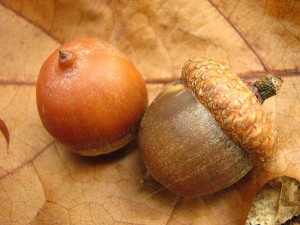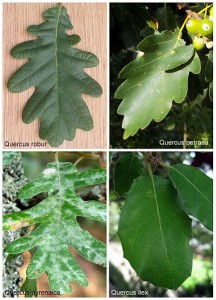
Oak Trees (Genus: Quercus) are deciduous or evergreen broad-leaved trees or shrubs that grow all over the world. There are over 550 species of Oak Trees worldwide. Oak Tree acorns were a staple food for Native American Indian tribes and other indigenous people around the globe. Oak Trees are very common and produce edible acorns in abundance in the fall. Acorns can be harvested from the ground for weeks after they have fallen. Acorns are a great source of calories considering how easy they are to harvest, and the quantity in which they can be found. Since most acorns contain a significant amount of bitter tannin they must be prepared properly to be palatable.
Edibility and Culinary Use

The acorns of the Oak Tree are the only edible part. They contain tannin which is a bitter chemical that prevents animals from eating them to abundantly. different species contain different amounts of tannin, some acorns are palatable right off the tree, but not many. The quickest way to remove the tannin is to thoroughly mash up the peeled acorns and wash repeatedly in cold water(not hot), changing the water frequently. You’ll see the water change color meaning that the tannin is leeching out of the acorn mash. Just keep leeching until the acorn mash does not taste bitter. The taste of acorn is bland, like grain or nuts, but it makes a great addition to many meals. Dried mashed acorns are known as acorn flour and can be added to baked foods like cakes and bread. One popular way to cook acorns is in Acorn Pancakes.
Health Benefits

The calorie content in acorns is only slightly less than many breads. One primary difference between the two is that bread calories are almost all starch while acorns calories are made up of more fats. Fats digest slower than starches, so acorns are a good source of long lasting energy. we can see why they were such an important food for indigenous people. This type of energy rich food was difficult to find without digging for tubers or hunting.
Cautions
There are no notable cautions when foraging for acorns. Acorns containing tannin tastes horrible so you would realize you need to leech it first. Another thing worth mentioning is that fallen acorns foraged from the ground often contain acorn weevil grubs. These insects are harmless so no need to panic if you don’t get them all out, leaving them in gives you more protein anyways.
Key ID Feature

Oak leaves range in shape and size so the best way to identify an Oak Tree is by looking for acorns. Oak trees and their close relative in the Lithocarpus genus are the only trees that have acorns. both plants have edible acorns so for foraging purposes it’s not necessary to distinguish between the two.
Conclusion
Acorns have a long history of being especially important for people living off the land. Calorie intake is one of the most important aspects to consider when living off the land. Acorns are common enough that they can be introduced to our diets regularly, and provide a healthier option for calorie intake compared to the many processed foods that are common today.
Read our Article on: Safe Foraging
Many of our readers find that subscribing to Eat The Planet is the best way to make sure they don't miss any of our valuable information about wild edibles.
See our privacy policy for more information about ads on this site







2 Responses
Some acorns contain tannins and are inedible. Tannins have an orange color and give food an orange color such as in persimmons. Tannin-rich acorns can be recognized by their orange color, such as in the sand laurel oak. I have eaten edible acorns before, and the innards of those are white. Edible acorns taste like almonds. I’m surprised that they sell tannin-rich persimmons in stores.
I have terrible allergies to oak trees and leaves, and all the above. If I eat the Acorn , maybe l could build up my immunity.